Let’s be honest – tubes are a bit weird. Wiggly black bands of rubber, tubes are tedious to install, constantly need to be re-inflated and can be defeated by the tiniest thorns. When it comes time to purchase a new tube, how do you know which one to select?
Between the dozens of size options and the various valve stem types (Presta, what is that?), selecting the correct tube for your bike can be challenging. Check out our video below, or scroll down for a quick photo guide to help you select the perfect tire tube for your bicycle:
There are two important dimensions you must know when selecting a tube: The diameter of your wheel and the width of your tire. You need both to select the correct tube size. These dimensions can be found on your tire: Diameter x Width.
The first number is the diameter of your wheel. Sizes such as 26, 24, 20, 27.5, 29 and 700c are common tire diameters. The second number (after the X) is the width of your tire. The range for widths is usually between 1 and 3 inches. For example, a 26 x 1.75 size means the tire diameter is 26 inches and the tire width is 1.75 inches.
While your diameter measurement needs to be exact, your width measurement does not. Because inner tubes stretch, they typically come in a range of widths. For example, one of our most popular tubes is the 26 x 1.75-2.125” which means it fits a 26-inch diameter tire with a width in the range of 1.75 to 2.125 inches.
Some tires have dimensions in millimeters, but the basic measurement structure is still the same: Diameter x Width. Instead of inches, you will instead see something like 700c x 18 mm. The letter at the end of the tire diameter is a carryover from an old French system that used letters a, b and c to designate inner wheel rim diameters.
After you know your tube size, you need to select your valve stem type. The valve stem is the metal part of the bicycle wheel that sticks out and allows air to go into (and stay in) your tire. There are three types of valve stems: Schrader, Presta and Woods/Dunlop. The Woods (or Dunlop) valve stem is extremely rare and typically only found in the Netherlands or Asia, so we won’t spend any time on it here.
Schrader valves, on the other hand, are the most common valve stems found on bicycles. The most recognizable of the bunch, sometimes they are referred to as standard valves. An easy way to remember if you have a Schrader valve is to think of the “S.” Schrader valves are short, sturdy and standard. If you don’t know what valve stem you have, it is likely a Schrader.
The last valve stem type is Presta. Presta valves are traditionally found on higher-end bicycles preferred by professional cyclists. Think of the “P” in Presta standing for professional, performance and premium.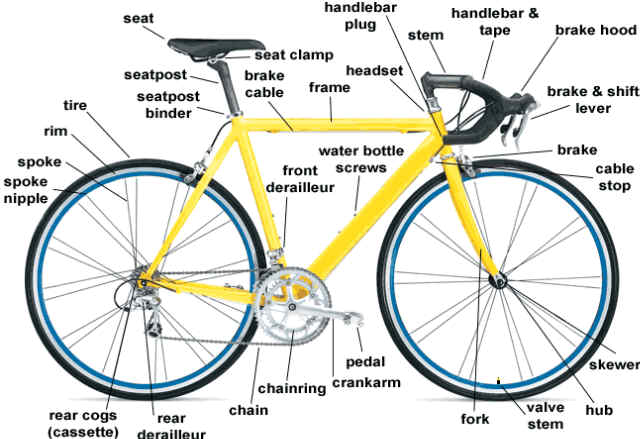 If you have a Presta valve, you usually know it.
If you have a Presta valve, you usually know it.
The last consideration you need to keep in mind when selecting a tube is durability. There is no reason for you to suffer from flat tires - Riding flat free can be a reality. Self-sealing tubes are heavy duty and designed to stop flats for up to two years! To gain that type of protection, you need to purchase tubes that come pre-installed with Slime tire sealant.
Alternatively, if you already have empty tubes, but want the protection that self-sealing tubes provide, you can insert the tube sealant yourself. Learn more about tube protecting sealant here.
Congratulations, you are now a tube expert! When purchasing tubes, if you consider tire size, valve stem type and durability needs, then you will never select the wrong tube again. Go forth and start riding!
Your bicycle’s tires might not be something you think about very often, but they have crucial implications for every aspect of your ride.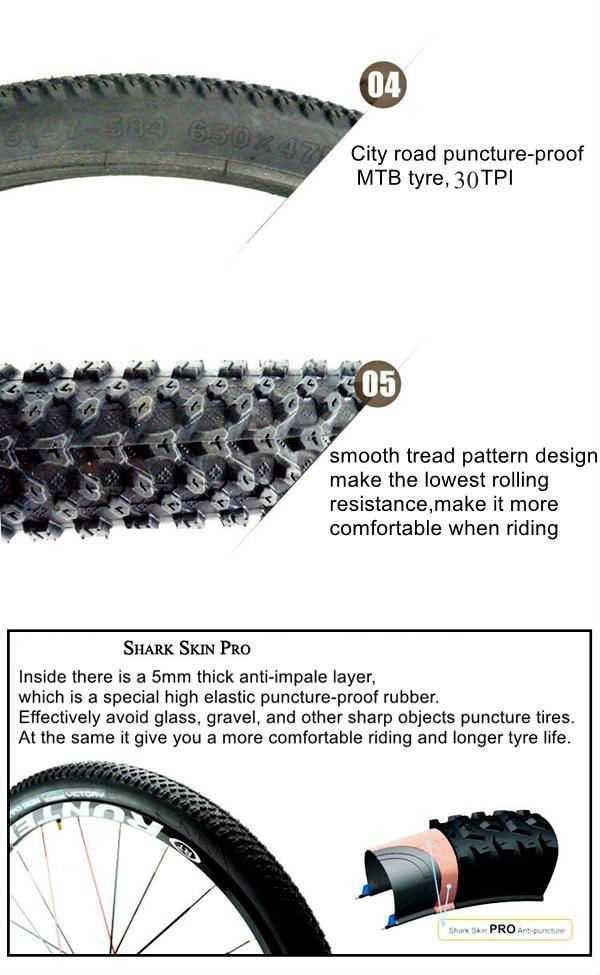 Better understanding how your mountain, gravel, and road bike tire size is measured can help you fine-tune your equipment, and learning how tire size relates to performance can make you faster when it counts. What are the basics of bike tire size?
Better understanding how your mountain, gravel, and road bike tire size is measured can help you fine-tune your equipment, and learning how tire size relates to performance can make you faster when it counts. What are the basics of bike tire size?
Bike tires are typically measured in two dimensions— diameter and width. The diameter measurement is an approximation of the tire’s total outside diameter including treads, and the width is a measurement of the approximate total width of the tire when mounted and inflated. For mountain bike tires these dimensions are expressed in inches, while a millimeter-based system called French sizing is used for road, gravel, and track. For example, a 29 x 2.25 mountain bike tire is about 29” in diameter and about 2.25” wide, while a 700c x 25 road tire is approximately 700mm in diameter and 25mm wide.
This makes it pretty straightforward to fit a modern tire to a modern rim—a 700c tire will almost definitely fit a 700c road rim (we’ll explain that “c” later), and a 29” tire will likely fit a 29” mountain bike rim. But some obsolete or unusual sizes can be misleadingly labeled, and any tire’s nominal measurements (especially width) are really just approximations. Rim width and tire pressure can significantly influence the size of a tire when mounted and inflated, and tires often measure a bit larger or smaller when installed than the printed dimension would suggest.
But some obsolete or unusual sizes can be misleadingly labeled, and any tire’s nominal measurements (especially width) are really just approximations. Rim width and tire pressure can significantly influence the size of a tire when mounted and inflated, and tires often measure a bit larger or smaller when installed than the printed dimension would suggest.
To reduce confusion, most tires are also labeled with a second system of measurements called ISO (formerly known as ETRTO). The ISO measurement displays the tire’s nominal width in millimeters, followed by the diameter of the tire’s bead (the surface that actually attaches to the rim) in millimeters (ex: 25 x 622 is a common road tire). This measurement can help resolve any ambiguity about whether a tire will fit a particular rim, but as with other systems, the ISO measurement of a tire’s width is an approximation and may be impacted by pressure and rim width.
Nearly all modern road bikes use 700c wheels and tires. It used to be widely accepted that narrower tires were faster and 23mm was the standard width. But recent research has proven wider tires to be faster and more comfortable in most situations. As a result, 700c x 25mm and 700c x 28mm are now the most common road tire sizes; many riders prefer even wider widths of 30mm or 32mm. The limiting factor is usually the bike itself, with some frames unable to accommodate tires beyond a certain width. Most new road frames can at least fit up to 28mm tires but double-check your frame’s allowance before sizing up.
It used to be widely accepted that narrower tires were faster and 23mm was the standard width. But recent research has proven wider tires to be faster and more comfortable in most situations. As a result, 700c x 25mm and 700c x 28mm are now the most common road tire sizes; many riders prefer even wider widths of 30mm or 32mm. The limiting factor is usually the bike itself, with some frames unable to accommodate tires beyond a certain width. Most new road frames can at least fit up to 28mm tires but double-check your frame’s allowance before sizing up.
A few other less common wheel and tire sizes exist for road bikes. 650b (ISO 584) and the rarer 650c (ISO 571) are two examples, both sometimes used on bikes for smaller riders. The letter that follows the diameter measurement in French tire sizes originally delineated width, but it’s now mostly just useful to differentiate between similarly-named but incompatible sizes. For instance, a 650b tire will not fit on a 650c rim.
It’s also important to understand the different types of mutually-incompatible road tires. Clinchers are most common; these are the familiar tires that seat into a walled rim around an inner tube. Certain clincher rims can also be used with tubeless tires, which use a liquid sealant in place of an inner tube. Finally, tubular tires are permanently sewn closed around an internal tube and are glued into a specially-made rim. All 3 of these tire types use the same sizing standards and terminology but are generally not interchangeable.
Clinchers are most common; these are the familiar tires that seat into a walled rim around an inner tube. Certain clincher rims can also be used with tubeless tires, which use a liquid sealant in place of an inner tube. Finally, tubular tires are permanently sewn closed around an internal tube and are glued into a specially-made rim. All 3 of these tire types use the same sizing standards and terminology but are generally not interchangeable.
Tires are printed with a manufacturer’s recommended pressure range, and road riders used to think inflating their tires to the highest possible pressure was fastest. But with the move to wider tires has also come a trend towards lower pressure. The science of tire pressure is complicated, but wider tires require less pressure for the same volume of air than narrower tires, allowing for a more comfortable ride. Additionally, wider tires at lower pressures reduce bouncing and are actually faster on most surfaces than smaller, harder tires.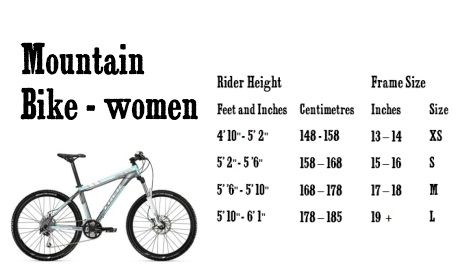
It’s tough to make a generalized recommendation for pressure—riding conditions, your weight, and the tire’s size all play a part. But generally, the larger the tire and the rougher the surface, the lower the optimal pressure. With each 3mm increase in tire width, you can usually reduce pressure by 1 Bar (~14 psi). Also, tubeless tires can generally be ridden at lower pressures than tubed tires of the same size. Some tire and rim manufacturers have calculators on their websites that make personalized recommendations for pressure; these are a great starting resource to make your ride faster and more efficient.
Adaptive Training
Get the right workout, every time with training that adapts to you.
Check Out TrainerRoad
Mountain bike tires are measured in inches and are offered in 3 non-interchangeable diameters corresponding to common mountain bike wheel sizes. Most popular for high-end mountain bikes are 29” tires and wheels. Next come 27.5” setups, preferred by some riders who like smaller, slightly more maneuverable wheels. And finally, 26” wheels and tires used to be the standard, but are now found mostly on entry-level and kids’ bikes.
Next come 27.5” setups, preferred by some riders who like smaller, slightly more maneuverable wheels. And finally, 26” wheels and tires used to be the standard, but are now found mostly on entry-level and kids’ bikes.
Tires at each of these diameters are available in a wide variety of widths, which riders select for the specifics of their discipline and terrain. Cross-country racers usually choose comparatively narrow tires ranging from 1.9” to 2.25” wide. Trail, all-mountain, and enduro bikes are normally equipped with wider tires between 2.25” and 2.4”, and downhill tires are even wider at 2.4” to 2.6”. Finally, fat bike tires are mounted on purpose-built rims and push the boundaries even further, sometimes measuring as wide as 5”. The specifics of tire choice are carefully considered by mountain bikers, with racers often choosing different widths and tread patterns depending on the course and conditions.
Interestingly, most mountain bike wheel sizes are actually the same diameter as road wheels—29” wheels are equivalent to 700c, while 27.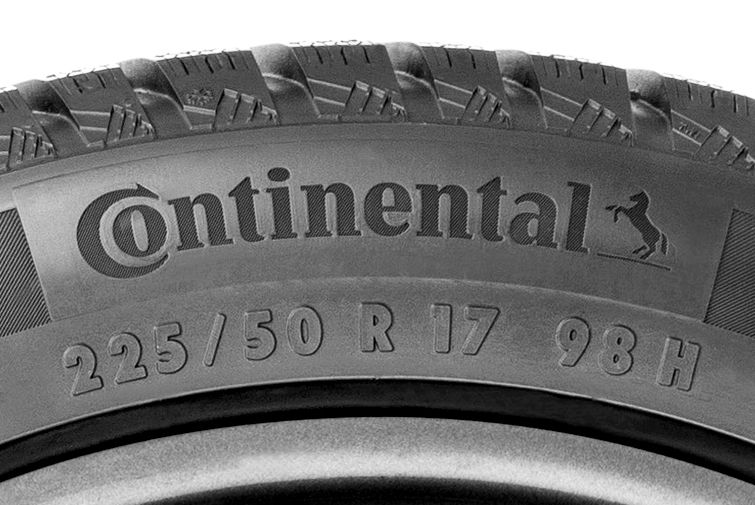 5” are the same as 650b. But you wouldn’t want to put tires intended for one on a wheel intended for the other, as the rim’s width is dramatically different for road and mountain bikes and would interfere with the tire’s performance.
5” are the same as 650b. But you wouldn’t want to put tires intended for one on a wheel intended for the other, as the rim’s width is dramatically different for road and mountain bikes and would interfere with the tire’s performance.
Tire pressure is a crucial concern in mountain biking. Small changes in pressure can dramatically impact performance and handling on the trail, and experienced mountain bikers regularly adjust pressure depending on terrain, conditions, riding style, and tire choice.
Because all of these variables are factors to consider, it’s nearly impossible to make a general recommendation for mountain bike tire pressure. Online calculators can help suggest a starting pressure based on equipment, weight, and conditions, but in the end, it’s ultimately a matter of personal preference and learning from experience. A good strategy is to treat the first few rides on a new setup or in new terrain as experiments. Carry a digital gauge, start with pressure on the higher side, and gradually let a few psi out/ add some pressure back in as you ride to experiment with what works and feels best.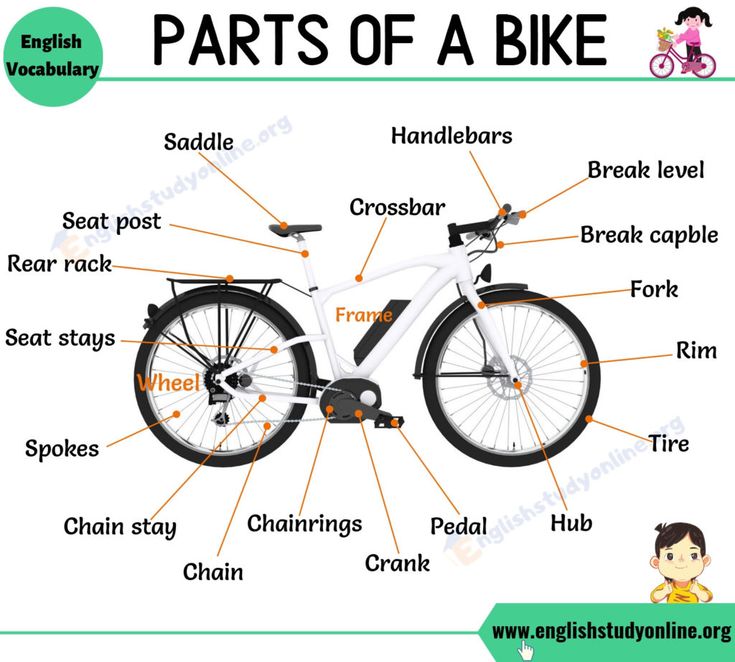 Check and record your pressure when you find the sweet spot and use this as your starting point for future rides.
Check and record your pressure when you find the sweet spot and use this as your starting point for future rides.
There are a few general principles to keep in mind when finding the right pressure. Typically, the larger your tire, the lower the optimal pressure. Tires with thinner casings require higher pressure, as do heavier riders. Rocky terrain may also necessitate higher pressure to avoid flats, while lower pressures can be used in smooth, grassy, or muddy conditions. Finally, some riders like to use tire inserts, which provide more flat protection and allow a few psi reduction in pressure.
Gravel, cyclocross, and track cyclists also choose specific tire sizes and pressures to optimize performance.
Cyclocross bikes use 700c road wheels, so cyclocross tires are all designed for this standard diameter. In the past, most serious cyclocross racers used tubular tires, but tubeless tires have become increasingly popular over the last few seasons. Tires at CX events have traditionally been allowed up to a maximum width of 33mm, and UCI-governed events still impose this limit. Non-UCI races often allow larger tires, such as the 38mm maximum width allowed at USA Cycling masters, collegiate, and single speed national championships. Many local events impose no size restrictions at all—check your race’s rules to know for sure.
Tires at CX events have traditionally been allowed up to a maximum width of 33mm, and UCI-governed events still impose this limit. Non-UCI races often allow larger tires, such as the 38mm maximum width allowed at USA Cycling masters, collegiate, and single speed national championships. Many local events impose no size restrictions at all—check your race’s rules to know for sure.
Gravel bikes used to be repurposed cyclocross bikes, but with dedicated gravel equipment introduced over the last few years tire options have greatly expanded. Most gravel bikes use 700c wheels, but 650b wheels are occasionally used for especially technical trail riding and bikepacking. Most new gravel bikes have clearance for tires ranging up to at least 42 or 45mm width, and some allow for even wider tires. Virtually all gravel riders use tubeless tires.
Gravel tires all balance speed and efficiency with offroad traction. Narrower tires with minimal treads are fastest on hardpack and paved surfaces but offer poor grip in loose corners. Wider tires with more aggressive tread patterns are more capable on loose terrain but roll much more slowly on smooth or paved roads. Gravel riders choose the width and tread pattern that offers the best balance for their local terrain, but may significantly adjust their tire choice and pressure for different conditions.
Wider tires with more aggressive tread patterns are more capable on loose terrain but roll much more slowly on smooth or paved roads. Gravel riders choose the width and tread pattern that offers the best balance for their local terrain, but may significantly adjust their tire choice and pressure for different conditions.
Like road bikes, track bikes use 700c wheels. But unlike on the road where slightly wider and softer tires are usually faster, on a smooth track harder and narrower tires have an advantage. For this reason track racers still prefer 21mm – 23mm wide tubular tires inflated to very high pressures—usually 150 psi or more on indoor tracks. Racers on rougher outdoor tracks don’t inflate their tires quite this high, but they still use much more pressure than they would on the road, with relatively narrow tires offering little in the way of puncture protection.
| Tire Size | Use/ Discipline | ISO Designation |
|---|---|---|
| 700c x 23mm – 32mm | Road/Track | 622 |
| 700c x 35mm – 50mm | Gravel and Mixed surface | 622 |
| 650b x 23mm – 25mm | Small road bikes | 584 |
| 650b x 45mm – 50mm | Gravel and Bikepacking | 584 |
26” x 2. 1” – 2.3” 1” – 2.3” | Cross Country MTB | 559 |
| 26” x 2.3” – 2.5” | Trail | 559 |
| 26” x 2.4” – 2.6” | Enduro/ Downhill | 559 |
| 27.5” x 2.1” – 2.3” | Cross Country MTB/ Gravel | 584 |
| 27.5” x 2.3” – 2.5” | Trail | 584 |
| 27.5” x 2.4” – 2.6” | Enduro and Downhill | 584 |
| 29” x 2.1” – 2.3” | Cross Country MTB | 622 |
| 29” x 2.3” – 2.5” | Trail | 622 |
| 29” x 2.4” – 2.6” | Enduro and Downhill | 622 |
bike tire pressurebike tire sizegravel bike tiresmountain bike tiresroad bike tires
Edited: 01/10/2021
All bicycle tires have some numbers and not everyone knows what they mean. However, this applies not only to them, but also to the inscriptions on the wheels of balance bikes, scooters, baby and wheelchairs. Let's try to understand this simple question.
Let's try to understand this simple question.
Everything is simple and clear. Any self-respecting manufacturer will write their name on the tire.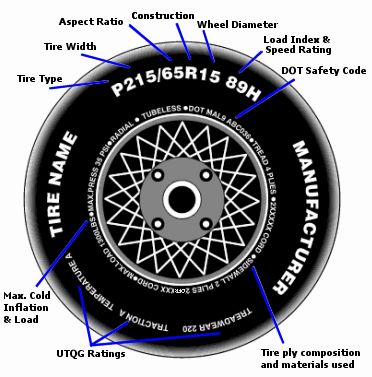
By the way. Some information about the labeling of manufacturers of Soviet bicycle tires.
In the USSR, there were many tire factories that produced products for all types of wheeled vehicles: automobile, motorcycle, bicycle, etc. Moreover, many of them continue to work even now, having changed owners and forms of ownership.
Tires were marked with trademarks or letters.
This tire marking applies not only to bicycle tires, but also to automobile, motorcycle and other tires produced in the USSR.

Appears on all tires, even those without manufacturer's name. Specify either in millimeters or inches.
Specify either in millimeters or inches.
Tire size is usually indicated by or in accordance with the standard of the European Tire and Rim Technical Organization (ETRTO).
In this case, the smaller number is the width of the tire, and the larger one is its diameter, i.e. in the figure, a tire with a width of 52 mm and with an inner diameter of 559 mm.
In inches: 2.00" wide and outer 26" diameter.
Inch markings have a drawback: they are not 100% accurate. For example, bike tire diameters of 559mm, 571mm and 590mm would be referred to as 26”. Bike tires that have diameters of 622mm and 635mm will be 28-inch.
Sometimes, like this picture, the tire says it can fit between 1.95" and 2.1" widths, suitable for rims that can fit 1.95" to 2" tires, 1 inch, and, accordingly, choose a bike tube of the same size.
You can get a general idea of what the numbers in the different size labels mean by looking at the "Tire Marking" chart shown here.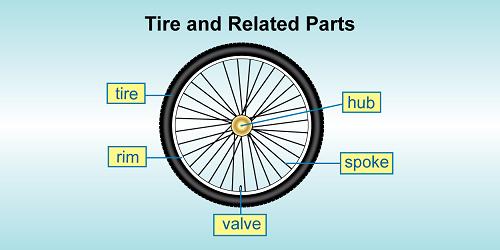
The basic and most accurate designation of dimensions is the dimensions according to the ISO system (ETRTO). It is marked in blue on the diagram.
In it, the numbers indicate the dimensions in millimeters. The first digit is the width of the rubber, and the second is its inner diameter . It is also with a bore diameter of rims.
Inch and oldest marking type. Shown in black on the diagram.
There are two types.
First type: Two digits, eg 28 x 1 3/8. Where 28 is the tire size in inches by outer diameter , and 1 3/8 is its width, in this example: one whole and three eighths of an inch.
This is the most common bicycle tire size designation.
Second type: three digits. For example, 28 x 1 5/8 x 1 3/8. Here the numbers mean respectively: 28 is the outer diameter in inches, 1 5/8 is the height of the bike tire in inches (one whole and five eighths of an inch), 1 3/8 is the width of the bike tire in inches.
There is also a French marking (crimson in the diagram). It is less common in our country, but on rubber produced in Europe this is a fairly common type.
An example of a French tire label is 700 x 35C. Here the outer diameter of the tire is 700 mm and its width is 35 mm. The letter on the end indicates the inner diameter of the tire. In this case, C is 622 mm.
For more information about size marking types and their interchangeability of , see the article "Bicycle Tires: Sizes, Marking Types and Interchangeability".
In general, there is a separate article on the pressure in bicycle tires on our website, and here we only note that inscriptions of this type mean the minimum and maximum pressure for which this tire is designed.
The inscription in English " Inflate to min ..... max " literally translates as "Inflate to ..." ("Inflate to", "Pressure from . .. to ...").
.. to ...").
For example, the figure below indicates that the pressure should be from 36 to 60 PSI (250 to 420 kPa) or 2.5 atmospheres to 4.2 atmospheres, respectively.
Let's explain what BAR (atmosphere), PSI and kPa are.
The relationship between BAR, PSI and Pa is as follows: 1 Bar = 100,000 Pa (100 kPa) = 14. 504 Psi.
504 Psi.
View the conversion table from BAR to PSI here.
So, when inflating a tire, you need to understand that the pressure in it should not be lower than the minimum and higher than the maximum. It is worth noting here that it is better to leave a small margin of 0.2-0.5 atmospheres without inflating the tire to the maximum value so that it does not burst, especially in hot weather.
Remember that pressure is not held by chamber , namely tire .
If the word COLD (cold) is written after the indication of the minimum and maximum pressure in the tire, this means that you need to measure the pressure in a cold tire.
Bicycle tires are most often symmetrical. Such slopes can be installed on either side.
But there are also specialized tires with a non-symmetrical tread pattern. They should only be installed as indicated on the tire itself. The responsible manufacturer will definitely indicate with arrows how to install it correctly. Usually these are English words:
They should only be installed as indicated on the tire itself. The responsible manufacturer will definitely indicate with arrows how to install it correctly. Usually these are English words:
The photographs below show such tires with indication of the direction of rotation of the wheel when mounted on a bicycle.
or
In the following illustration, the tire can be mounted on the front wheel as well as the rear, but with regard to the direction of rotation of the wheel. Those. when installing a tire on the rear wheel, look at the arrow Rear (rear) and set it in such a way that the rear wheel spins in the direction of the Rear arrow. When installing the same tire on the front wheel, pay attention to the arrow Front (front, front side). The tire mounted on the front wheel rotates in the direction of the Front arrow.
If the tire is designed for the front wheel only or only for the rear wheel, then the corresponding inscription is made on it. As, for example, in the photo below, which shows a tire designed only for installation on the front wheel. It also indicates in which direction the wheel should rotate.
I would like to dwell on one more point.
If the manufacturer has clearly indicated how to install asymmetrical tires on wheels, everything is simple and clear. But sometimes a situation arises when there is no such inscription on a unidirectional tire. How to act in this situation?
First of all, make sure that the tread pattern on the tire clearly looks like the English letter “V”. When installing such a tire on a wheel, follow the rule: if you install it on the rear wheel, it should leave a trace of the form: “>>>>>>>”, and the front one, on the contrary, of the form: “<<<<<<<<”. This is a picture if you imagine that the bike is traveling from left to right.
Why is that? The rear wheel is more responsible for traction, ensuring the bike's cross-country ability. Therefore, it seems to rest on the road with two legs of the letter "V" and creates a better grip with it.
The front wheel is responsible for the bike's maneuverability and braking. Therefore, when braking, the front wheel already rests on the road with two legs of the letter “V”.
This is especially important when driving on dirt roads, earth, sand. When driving only on asphalt, this will not matter much.
If the tire is labeled Front Only , it is designed for front wheel mounting only.
This is due to the fact that these tires are made from a very soft material with low stiffness, which provides better control of the bike while driving, but less wear resistance of the tire. On the rear wheel, it will be erased much faster.
Usually such tires are used in extreme disciplines - downhill, etc.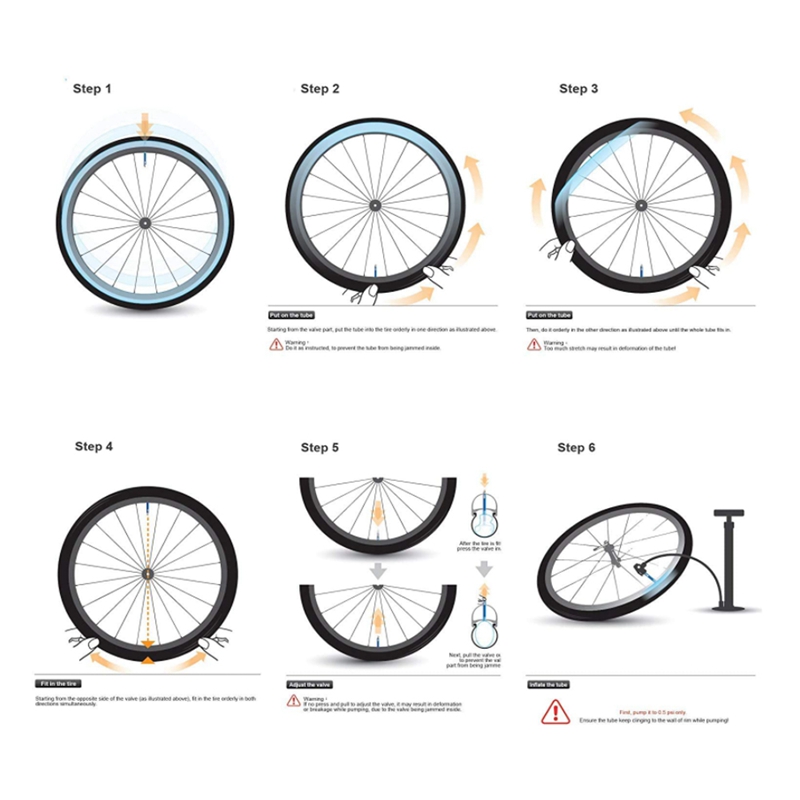
The question is often asked: "How to determine the date when the tire was made?". Conscientious manufacturers indicate on the tires the date (year and month) of the tire release.
The manufacturing date of tire is defined as a four-digit number, the first two digits of which cannot exceed 52. Why? In this number, the first two digits indicate the week of the year the tire was produced (there are 52 of them in a year), and the last two - the last two digits of the year of production.
Most often, these numbers are in an oval, as in the photo:
We have considered the main types of inscriptions that manufacturers most often write on their tires.
But some of them also write additional information or explanations.
For example, any additional information about the manufacturer, the address of their website, where you can read about him and the tires produced, the possibility of using in the cold season, and indeed everything else that they see fit.
Lettering Nylon (nylon) means that the tire cord is reinforced with nylon threads. Read more about this in the article "Which tire to choose for a bike."
For example, in the figure below, the tire says that the tread (Tread) consists of Polyester, reinforced with steel threads (Sleel) and nylon (Nylon), and the sidewall (Sidewall) is reinforced with polyester.
If the tire can be used in cold season , it will have " W ", " Winter ", " All seasons 3" or a snowflake painted on it.
Most often, these words ("Winter" or "all seasons") are also present in the tire name itself.
The main rubber on winter tires should be studded, soft and not tan in the cold.
For more information on how to increase tire grip on winter roads, see the article "How to increase bike grip on snow in winter".
Sometimes a tire is indicated on its maximum load capacity in kg (or pounds - LBS). For example, the tire in the photo below holds 125 kg or 275 English pounds. Of course, if the pressure on it is 150 kg, the tire will not immediately burst, but the risk of damage to it will be significant.
The maximum load is indicated at the maximum allowable tire pressure.
Most of all this applies to tires from a well-known manufacturer like SCHWALBE , but also suitable for others
COMPOUND - the tire is made of a compound: a mixture of rubber with various polymers and monomers.
| Lettering | Description |
| 23S | Marathon 23S is a special compound containing silicon (Silica) that provides good rolling and long tire life |
| Allround | Marathon Compound - Durable, longer mileage, excellent wet grip and low rolling resistance |
| DPC (Dual Ply Casing) | Double layer nylon weave for added protection |
| Dual Compound | The tire consists of two components for better "behavior" of the tire.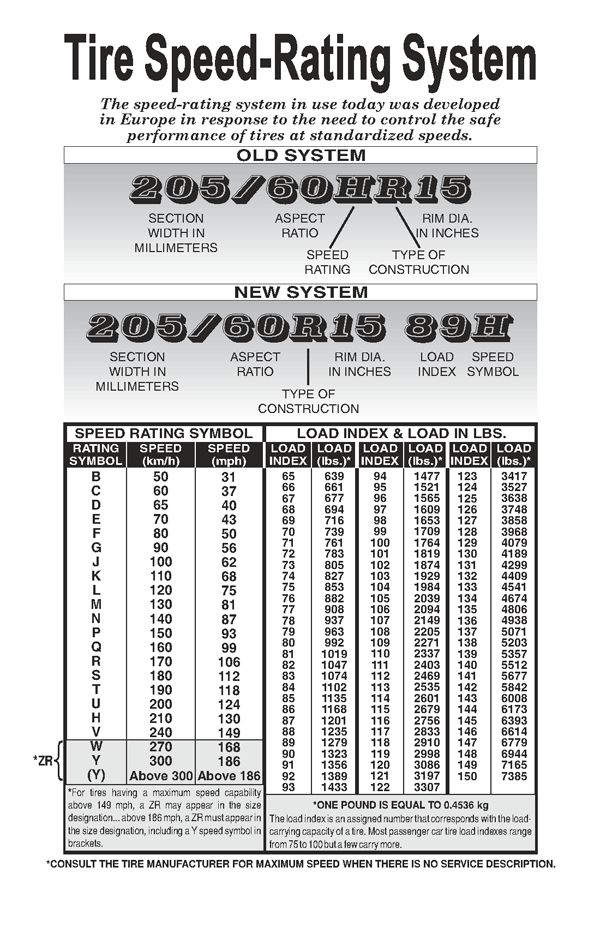 The center part of the tire in contact with the road is stiff for better wear resistance, while the sidewalls are made of a soft compound for better grip The center part of the tire in contact with the road is stiff for better wear resistance, while the sidewalls are made of a soft compound for better grip |
| DFC/DRC | Dual Front Compound / Dual Rear Compound - specially designed and optimized for Stelvio Evolution front and rear wheels. |
| ENDUR | Endurance - Abrasion resistant compound for maximum mileage for the Marathon XR | tire
| Gooey | Gooey Gluey - Extremely durable, soft material for better control on hard and loose trails (Muddy Mary) |
| Heavy Duty | The tire has a reinforced sidewall. Used in DownHill and FreeRide tires. Withstands heavy loads. |
| Hard Compound | Rigid material for soft marshy surfaces |
| Off-Camber Grip | Specially embossed side tread blocks improve wheel lean behavior. |
| ORC | Offroad Racing Compound is a compound for fast off-road tires. Optimal qualities for better off-road control |
| QC | Qualifier Compound - special compound guarantees low rolling resistance (Stelvio Light) |
| Light, LiteSkin | Lightweight tyre. Give it to those who fight for every gram of weight. These tires have worse puncture resistance! |
| L.S.T. | The inner edge of the tire has the property of preventing slippage on the rim when braking. |
| MGC | Maximum Grip Compound has very good grip on slippery and wet roads. |
| Magic | Compound for ultimate wet grip and rolling resistance |
| SBC | Schwalbe Basic Compound. Quality material for universal use in various conditions |
| Silica | Compound with a special silicon filler that significantly changes the properties of rubber, reducing rolling resistance |
| SPC (Single Ply Casing) | One layer of nylon fiber, covered with rubber, which is braided over the cord.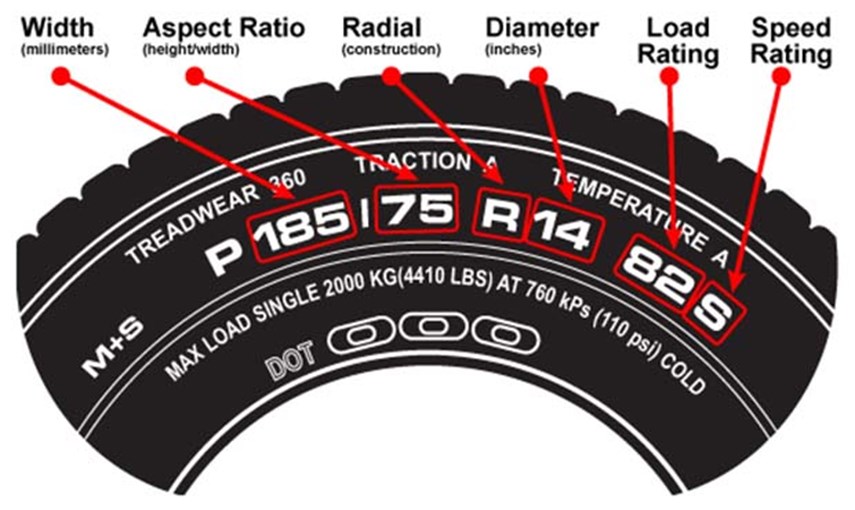 Single-layer weaving allows the tire to "lick" tracks with different terrain and reduces the weight of the tire. Single-layer weaving allows the tire to "lick" tracks with different terrain and reduces the weight of the tire. |
| Soft Compound | Extra soft compound for better grip on hard surfaces |
| SGC | SpeedGrip - multi-level dual compound for optimum performance (SuperMoto) |
| SnakeSkin | Special additional tire sidewall protection reduces the chance of scoring. |
| T45 | Special blend for road tubing, used in Montello tubing |
| Triple Compound | Three-layer compound. Allows you to optimally combine different characteristics in one tire (Nobby Nic, Racing Ralph, Furious Fred) |
| Wide-Gapp | Large stud spacing tread provides excellent self-cleaning performance and improved traction. |
| DGC (scooter) | Durable Silica Compound provides good rolling and long tire life |
| DSC (scooter) | Durable Silica-Grip Compound has very good grip in various conditions |
| FOC (scooter) | Front Only Compound - rubber compound (Soft) optimized for the front wheel of the scooter |
| S1A (scooter) | Winter Compound is a winter compound designed for slippery and icy roads |
Tire stiffness is indicated by a two-digit number with an "a" at the end.
For example: 40a, 42a, 57a/62a, 60a, 62a, 70a, . The higher the number, the harder the material.
They write this very rarely, but sometimes it happens. More often this parameter is indicated on the company label, packaging, or at least on the manufacturer's website.
This also includes the inscription ST or SUPER TACKY (English: super sticky), indicating that this is a very soft, usually with a stiffness of 42a, tire.
If the letters 3С are present on the rubber, this means that 3 types of compound were used in the production of the tire.
In general, there is a separate article on the stiffness of the compound on our website and you can read more about it in it.
Tires for MTB tires made with Addix were divided into 4 groups. And to simplify the differences, they began to be marked with a label on the side and a colored strip on the tread.
And to simplify the differences, they began to be marked with a label on the side and a colored strip on the tread.
Each group has different properties for different disciplines.
Addix Speed (red) - XC RACE
Rolls well and allows you to reach maximum speed. Has the best rolling resistance. Ideal for cross country racing. Grip is 15% higher, durability is 25%.
Addix Speedgrip (blue) - XC / AM / TRAIL
Good road holding. Versatile compound for rough terrain, long distances, small obstacles and climbs. Strength increased by 62%, grip by 35%.
Addix Soft (orange) - ENDURO / DOWNHILL
Designed for steep descents and climbs, overcoming serious obstacles. It has excellent rolling and cushioning, incl. at low temperatures. Durability increased by 49%.
Addix Ultrasoft (purple) - ENDURO / DOWNHILL
Designed for extreme descents and the toughest conditions with maximum cushioning. Significantly improved low-temperature properties, grip and shock absorption. Suitable for year round use.
Significantly improved low-temperature properties, grip and shock absorption. Suitable for year round use.
Red and blue are suitable for cross-country, orange and purple for freeride, downhill.
the density of the weave of the carcass of the tire or the number of cord threads per 1 inch.
EPI is more commonly used in Europe, and TPI is a more international designation, adopted throughout the world, but in essence they are the same thing.
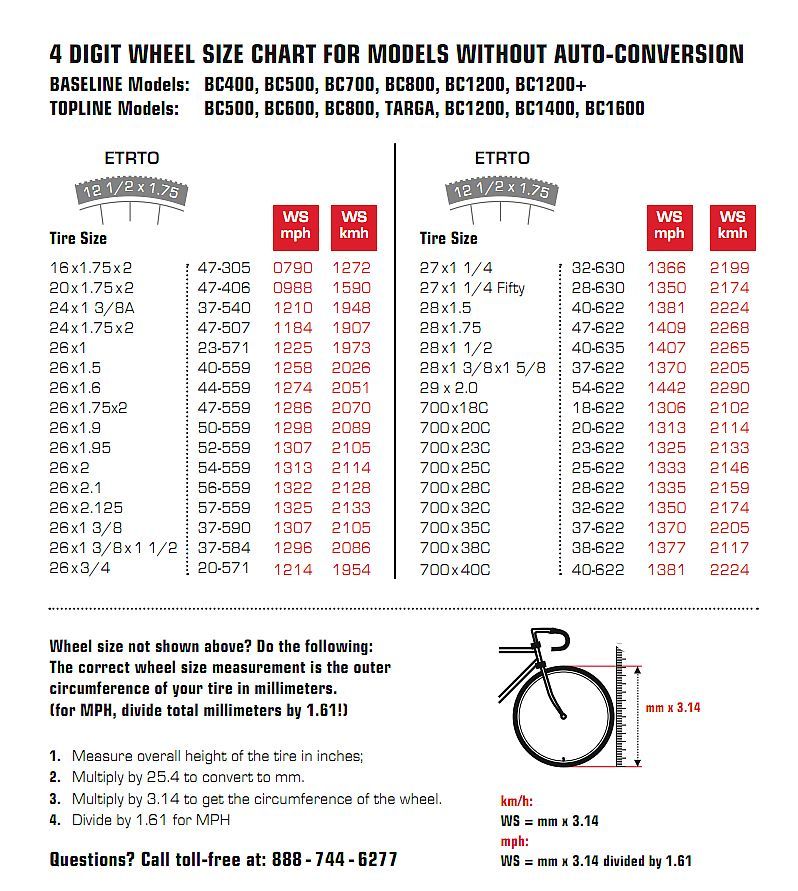 ) have a high TPI value - they have a dense carcass and a lot of rubber. But for this type of tires, weight does not matter. Here safety and reliability are paramount.
) have a high TPI value - they have a dense carcass and a lot of rubber. But for this type of tires, weight does not matter. Here safety and reliability are paramount. Higher TPI tires are stronger, harder to puncture and hold more pressure.
There are tires with a reflective layer applied to the side surface, which may be indicated by the corresponding inscription.
Commonly written: Reflex
Decals Tubeless0083 means the tire can be used without a tube.
Rubber markings like Anti-flat , Anti-puncture, Puncture protection, Puncture resistance, Flatless, means that the puncture protection layer is included in this tire.
The EXO Protection lettering on the bicycle tire indicates that an additional layer of Kevlar is woven into the sidewall of the tire, resistant to cuts and wear.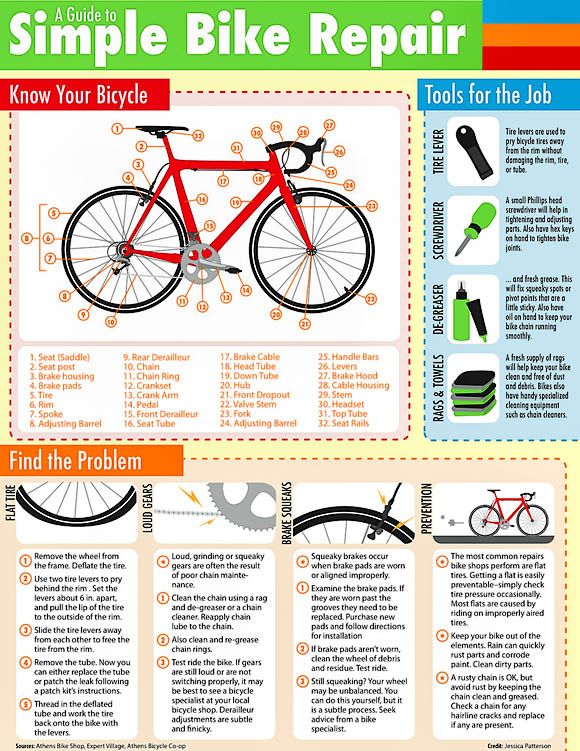
These tires are particularly well suited for rocky mountain trails, where there is a high chance of bead cuts.
Usually written on MAXXIS tires.
The bicycle is presented as a vehicle that constantly needs to be serviced.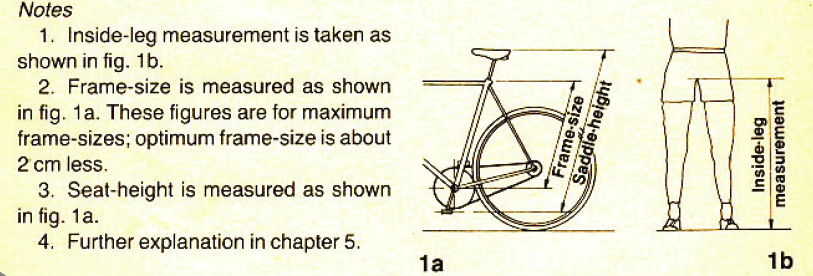 And bicycle tires are the fastest wearing part on a bike. When buying a new bicycle tire, the question is what size to buy and what tread will best fit the bike.
And bicycle tires are the fastest wearing part on a bike. When buying a new bicycle tire, the question is what size to buy and what tread will best fit the bike.
When determining the size of a tire, everything is simple, on each tire there are numbers that indicate the size. You just need to rewrite these numbers, and come to the bike shop with this tire data and you will easily find the right size. This is easy to do in the Kiev bicycle shop KupiBike on Kharkiv Highway. The bicycle shop has a bicycle workshop, which has a bicycle mechanic and can easily help you with the choice.
But sometimes you want to choose a tire yourself on the Internet, order it yourself on the site, buy in an online store. This can also be done through the online store kupibike.com.ua. To independently choose a tire for a bicycle, you need to know what measurements of bicycle wheels are, how tire sizes are determined. And understand what number means what: width, radius, diameter, tread, weaving density of the court (this determines the softness and strength of the tire).
In Ukraine, for a long time, the designation of tires was indicated in the unit of measurement "ETRTO". The measurement "ETRTO" meant: European Tire and Rim Technical Organization (technical specification of European tires and wheels). This approach to the designation is applied both for bicycles, and this standard of measurement is also used in motorcycle and automotive products.
When characterizing the "ETRTO" 37-622 standard, the meaning of the numbers is as follows: the number 37 indicates the width of the tire when inflated (working condition in millimeters), the number 622 indicates the internal size (tire diameter in millimeters). This approach to size is more detailed, and is not always justified. Since bicycle rim sizes can vary slightly in shape, this naturally entails slight differences.
Another thing is the ease of measurement in the modern world, the definition of a bicycle tire is not in millimeters, but in inches. It's simple and easy. Inch tire sizing found popularity in America, after which the popularity of bicycle tire size in inches became widespread.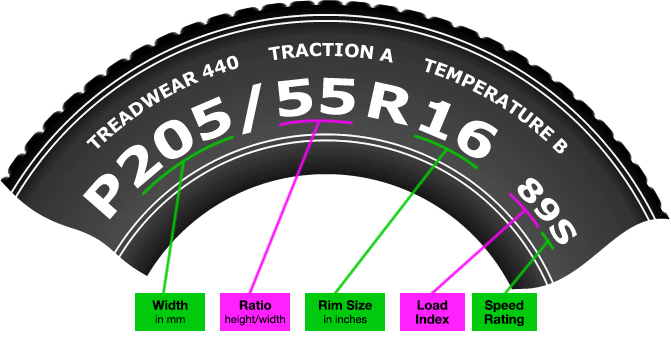 So, with a bicycle tire size of 26X2.10, it indicates the generalized dimensions of the tire. Where the number 26 indicates the approximate outer diameter of the tire, and the number 2.10 indicates the width of the tire. By "relative size" it means that all bicycle tires are made of rubber, and they have some stretch, which can be easily fitted to rims of different widths.
So, with a bicycle tire size of 26X2.10, it indicates the generalized dimensions of the tire. Where the number 26 indicates the approximate outer diameter of the tire, and the number 2.10 indicates the width of the tire. By "relative size" it means that all bicycle tires are made of rubber, and they have some stretch, which can be easily fitted to rims of different widths.
There is also another measuring scale for tire sizes, for example 28X1 5/8X1 3/8. And these numbers again indicate different sizes:
And with a variety of measurements, you have to be smart and choose the right size. All this does not always fit, because if you take a wheel size of 26 inches for different styles of bike, you will find differences in numbers: a 559 mountain bike(MTB), 571 (triathlon), 590 (road bike).